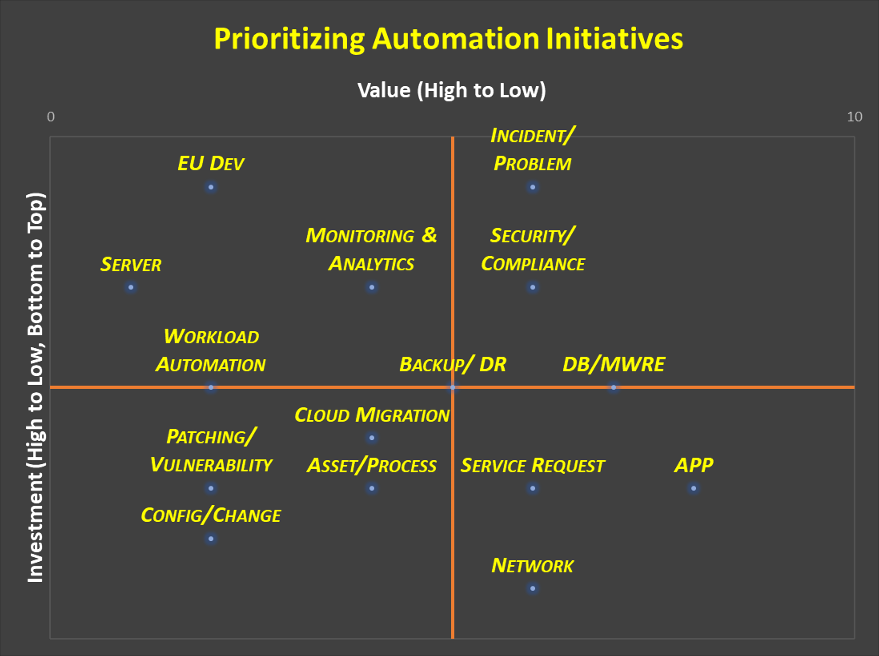Accelerating Infrastructure Automation
The Bottom Line
- We’re now over a dozen years into the ascent of cloud services. Yet, enterprise-managed workloads remain critical to many organizations, whether in on-premises data centers or colocation facilities.
- The sheer volume of work continues to increase as “always-on” has progressed from differentiator to “dial tone.” Finding legacy skills to manage operations, let alone improve processes, is getting more difficult.
- Infrastructure automation is required to deploy quickly, improve quality/reduce errors, reduce costs, and improve collaboration.
- Some organizations get stuck working on “the perfect plan.” Our observation and that of analysts we trust is that the organizations that succeed get started, accomplish, learn, “rinse and repeat.”
- GTSG has been automating infrastructure operations and workload migrations for every day of our three-plus decades. We don’t sell (or resell) tooling. We work for you and you alone.
Automation remains a top priority for infrastructure leaders
Critical core legacy workloads remain in enterprise-managed data centers (on-premises or in colocation facilities). Reasons range from performance, latency, security, data residency requirements, the absence of a business case for migration, or a shortage of cloud skills in an organization.
It’s interesting: despite the market share growth and the media attention paid to cloud migration, one recent Gartner survey tells us that data center automation is at the top of the list. Indeed, 59% of respondents have it ranked in the top three.[i]
Why? It’s straightforward enough.
- Volume: increased demands make manual scaling impractical
- Speed: we need to move quickly while minimizing errors
- Talent: while delivering a better experience, we must free up increasingly scarce infrastructure and operations talent for more fulfilling work.
Organizations see the need for a structured program. Gartner predicts that by 2025, 70% of organizations will implement structured automation to deliver flexibility and efficiency, an increase from 20% of organizations in 2021.[ii]
If it all makes perfect sense, what’s the challenge?
From what we see- confirmed by industry observers we trust – some organizations have trouble moving forward without a comprehensive long-term plan. The process of study seems to impede action.
However, we (and others) observe that successful organizations “begin where they are.” They select an effort to work on, get started with something, and build a program while learning along the way.
As much sense as that makes, there is a legitimate concern. The need for urgency can generate the risk of enabling silos of automation. As with any management challenge, an urgent need may motivate action but does not necessarily motivate broadly coordinated action optimized for the organization.
So how do we balance the short-term need for action with the equally vital need to reap the most from limited budgets and increasingly scarce talent?
We have an engagement structure that helps with this challenge.
A twin-track approach
Day One: we get everyone together and look at the opportunity before us.
Pilot for results and learning
In the orange boxes, we represent implementing a pilot program as crucial to the strategy engagement. We select a pilot based on the traditional criteria: visible, replicable, and with a reasonable probability of success. From Day One of working with GTSG, something is underway from which we can learn.
A tactical plan for the near term
We work with you to plan the next six to twelve months. Experience teaches that looking further detracts from the bias to action.
What does the engagement look like?
This engagement is a series of workshops run in parallel with our agile pilot project.
What’s the scope?
We survey the knowledgeable team for opportunities to automate deployment, operations, and management/governance processes.
- More common: server provisioning, application and device deployment, monitoring, load balancing,
- Increasingly network automation
- Less frequently incident resolution and vulnerability remediation,
- In some cases, continuous configuration automation and backup/disaster recovery
What’s the value?
- speed to market or agility,
- quality improvement via the reduction of manual intervention,
- in cost and efficiency plays, or
- in improved collaboration.
What investment do we need?
Finally, we need to look at the investment required to realize the promise of each given initiative, considering
- time to benefit
- cost- whether it’s software, personnel, training, or implementation assistance
- impact on other projects, which impact can be on budgets or in contention for potentially scarce skilled resources
- and, of course, consideration of any risks.
What are our priorities?
With a handle on the value and the required investment, we can take an analytical view of the priorities:
- upper right: begin here; higher value, but relatively lower investment
- lower right: great value, but with investment required, so start to build the business case
- upper left: not the highest priority, but relatively lower investment- proceed opportunistically
- lower left: lower value requiring higher investment; hold off and perhaps re-evaluate in the future.

We’ll deliver
- a high-level project plan that lays out a timeline for the first six to twelve months
- lessons learned from the pilot
- the priority methodology
- how we determined value
- calculated the required investment
- an assessment of the skills required going forward
- an evaluation of the impact on and potential integration with other initiatives
- at least the foundation of a governance structure that will keep the program alive and relevant
Consultants working for you and you alone
We do it from your perspective. We don’t sell tooling. Our only objective is to help you get further down the road. If we are qualified to help you implement, we’ll offer to help. Where we’re not – we won’t, and we’ll work to find you someone who is.
* * * * *
Thanks for your interest in GTSG’s approach to helping clients get real traction in their infrastructure automation initiatives. Please write us at Partners@GTSG.com for more.
[i] https://cloudsoft.io/blog/-infrastructure-automation-urgent-priority, retrieved 04.05.23
[ii] https://www.gartner.com/en/newsroom/press-releases/2022-10-03-gartner-survey-finds-85-percent-of-infrastructure-and-operations-leaders-without-full-automation-expect-to-increase-automation-within-three-years, retrieved 04.05.23

